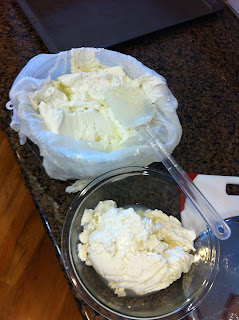I based this on Ricki Carroll's Home Cheesemaking book which has never disapointed so I am going to assume that I did something wrong with the salt. The end product did not develop mold and was way toooo salty, not edible...
I followed the recipe or so I thought
2 gallons of whole milk
Pinch of Penicillium roqueforti
Mesophilic starter 1/8 teaspoon
0.5 teaspoon double strengt liquid rennett
2 tablespoons cheese salt
Method
Batch 1
Heat 1 gallon of milk to 86 F and add mesophilic and blue mold - hold for 30 minutes
Dilute rennet and add with stiring
Let sit for 45 minutes at 86 F
Cut curds and place in cheese cloth and drain overnight
Batch 2
The next day repeat the steps above to make a second batch but drain for only one hour.
Cut Batch 1 into 1 inch cubes and in a second bowl do the same to the second batch
Add 2 tablespoons of salt to each batch (next time I will only add one to each)
The method is to fill a 2 pond mold with the dry material from Batch 1 in the center and the wetter Batch 2 on the outside. PLace the mold on a cheese mat and hold at 55-60F and flip every 15 minutes for 2 hours. Flip several times over 3 days.
Remove from the mold and rub with salt daily for 4 days and hold at 55F and 85% humidity.
Using a pin or knitting needle pierce top and sides
Hold at 55F for 30 days and then for 30 days at 50F. Scrape the surface free of excess mold
Age for 3 months longer and it is ready to eat.
==============
The cheese had some blue mold start to form during aging but by two months nothing. Perhaps it was the Penicillium roqueforti, but I don't think so. It was just so salty, it was also a bit too dry and crumbly which might indicate low humidity on stroage. I think I will contact Ricki and see what she thinks.





No comments:
Post a Comment